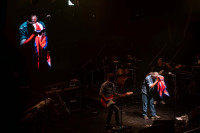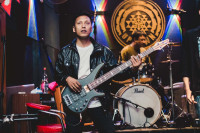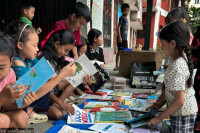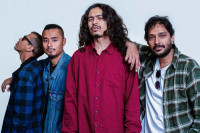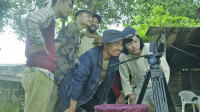Entertainment
Art as an investment
In March this year, E-Arts Nepal, an online art gallery established with an aim to promote contemporary Nepali arts, organised the maiden Himalayan Art Camp in the Lake City of Pokhara.
Timothy Aryal
In March this year, E-Arts Nepal, an online art gallery established with an aim to promote contemporary Nepali arts, organised the maiden Himalayan Art Camp in the Lake City of Pokhara. The organisers invited artists from Nepal and abroad—from Asian countries such as Malaysia, Vietnam, Thailand and China, among others, where the art practices are better than in Nepal—to the Camp where the artists engaged in discussion about contemporary arts around Asia and also created their own artworks.
The artworks thus created are currently on display at Nepal Art Council in the Capital, and they are, at once, beautiful to look at and are emblematic of the diverse contemporary art practices across Asia.
The first piece that caught my gaze as I entered the gallery hall, at second floor of the Council, was Shadow of Trees, a two piece series, by Titarubi, an artist from Yogyakarta, Indonesia. One of Indonesia’s pioneering female contemporary artist, Titarubi works on the medium Charcoal on Canvas; her works derive elements from sculpture, painting, installation and drawing. The first piece of the Shadow of Trees series depict about a dozen, almost crystalline, trees, and their shadows, interspersed by the sea. The second piece has a girl lying down, her gaze directly upwards, a tree, rooted in her stomach, rising in the air. The branches in this tree has birds, ready to fly, and beyond the tree, a flock of birds, scattered in chaos, give the piece an apocalyptic air.
Nepali artist Asha Dangol’s work combines traditional with the contemporary, mythical with the real. Her Anger of Machhapuchhre has as its subject a man wearing a Bhairav mask, looking through Macchapuchhre. While in The New Age, a man, who crudely resembles the mythical Ganesha, stands on a Vintage car, his face covered in a gas mask. “I was working on this theme for a while now, and once I got to the Camp, I thought I would resume it. I love Vintage cars to other commonplace cars... The pieces as you see may be read as concerns about consumerism, ecology and urbanisation,” artist Dangol said.
Touching upon a similar theme is artist Bhairav Maharjan’s work, Portrait of Kathmandu. The first piece has as its subject a Buddha, in his usual posture, with a dust mask to cover his face; another has a Shiva, also wearing a mask.
The exhibit also has works on display by artists such as Durga Baral, Trinh Tuan from Malyasia, Cong Kim Hua from Vietnam, and Jeevan Rajopadhaya, among others.
Speaking to the Post, artist Dangol, who also works with E-Arts Nepal, said that the Camp, besides the exchange with international artist, was organised to seek the possibilties of using art as investment in Nepal. “Like gold and silver, art too has a value, and its value rises in due time. In Nepal, the trend of using art as an investment is still in its infancy. Since the inception of E-Arts in 2010, we have seen it growing and we hope we will see it rising in days to come,” Dangol said.
The artworks on display at the exhibit will be put on view and sale at E-Arts Nepal’s website, eartsnepal.com. The exhibit will close on Sunday.




 22.12°C Kathmandu
22.12°C Kathmandu
